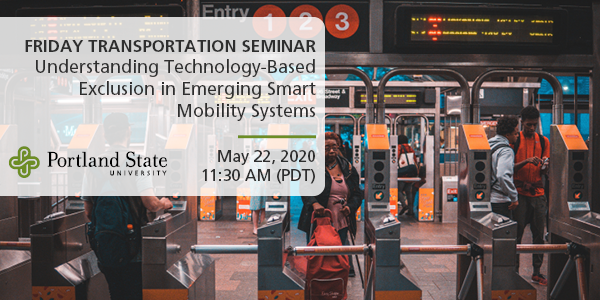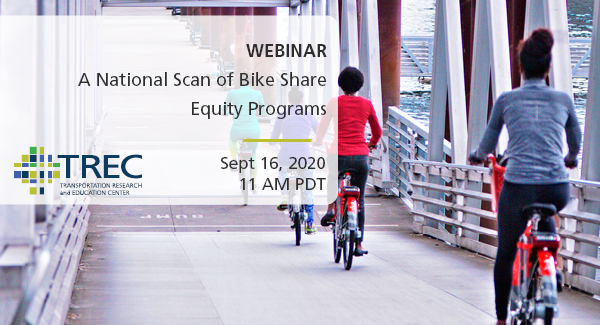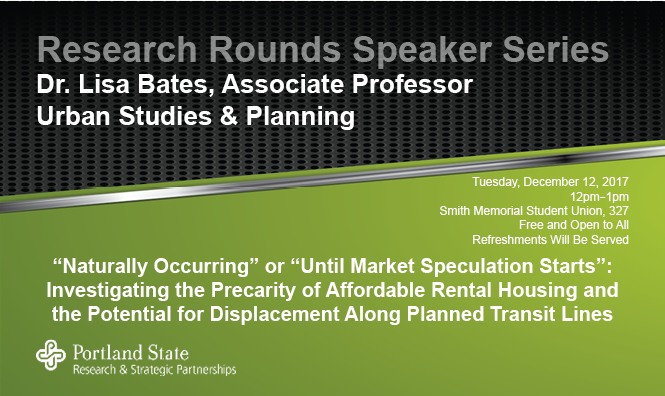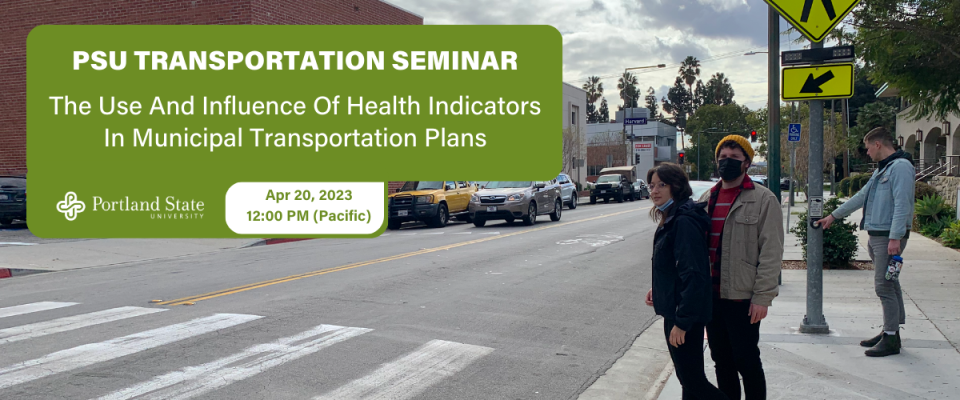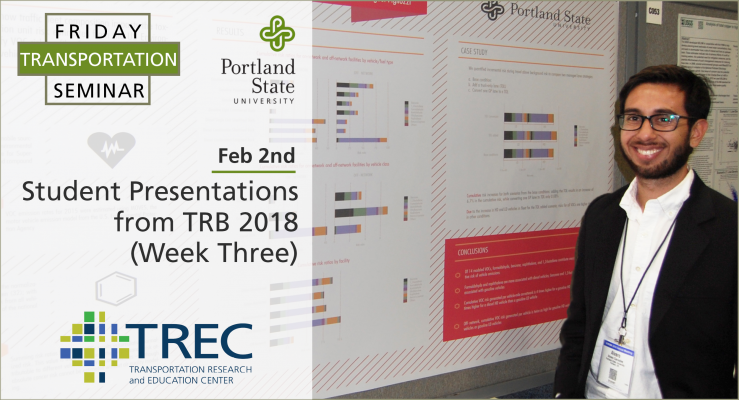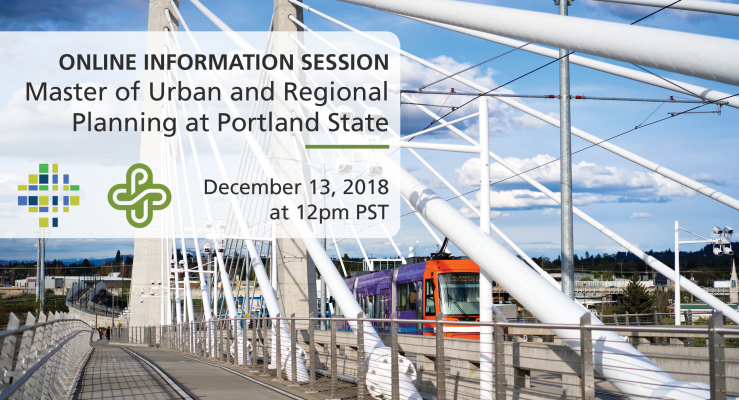We are committed to making decisions that promote the success and well-being of our campus community. Like an increasing number of universities nationwide, Portland State is taking steps to respond to the global pandemic. Until further notice, all live events hosted by TREC will be online only.
Friday Transportation Seminars at Portland State University have been a tradition since 2000. You can join us online at 11:30 AM.
PRESENTATION ARCHIVE
THE TOPIC
As transit agencies modernize their fare payment systems, opportunities to pay with cash are reduced. This speeds boarding and lowers the cost of operations while also creating new sources of ridership data. Arguably, service is improved for riders as well as payment systems could work across modes,...
Read morePRESENTATION ARCHIVE
OVERVIEW
Connecting with cities and bike share operators from across the United States, Portland State University conducted a nationwide scan on what programs and initiatives were running to address equity in bike share. The report “National Scan of Bike Share Equity Programs” documents responses from over 70 bike share systems. This resource will help cities and operators navigate the range of actions that have been implemented to make bike share systems more equitable, examine successful strategies employed across the U.S., and understand how those successes (and challenges) are being measured and articulated. In doing so, we hope the report helps bike share systems learn from the experiences of others, innovate, and more quickly move toward greater equity. The research team will be joined by a bike share operator to discuss what they learned, best practices, and where they see the future of bike share equity programs headed.
THE RESEARCH
This webinar is based on a study funded by the Better Bike Share Partnership and the National Institute for Transportation and Communities (NITC) and conducted at...
Read moreThis event was hosted by Portland State University's Research and Strategic Partnerships. See the schedule for the monthly Research Rounds Speaker Series here.
REVISIT THE LECTURE: VIDEO AND SLIDES
Miss the lecture or want a look back at the presentation? Watch the video, or view the presentation slides here.
"Naturally Occurring" or "Until Market Speculation Starts":...
Read moreTransportation Seminars at Portland State University have been a tradition since 2000. Formerly known as the Friday Transportation Seminar series, we've opened up PSU Transportation Seminars to other days of the week to better accommodate attendance. You can always watch online via Zoom.
PRESENTATION ARCHIVE
THE TOPIC
As a social determinant of health, transportation significantly contributes to well-being through several pathways. Researchers and practitioners have called for health indicators as one way to integrate public health concerns into transportation decision-making. However, it is unclear how indicators are used and what their impact is on policy. This case study of five cities explored how health-related indicators are being used in municipal transportation plans, whether they are institutionalized into transportation agency...
Read moreWatch video
View slides: Bell Presentation (PDF)
Summaries:
Identification and Characterization of PM2.5 and VOC Hot Spots on Arterial Corridor by Integrating Probe Vehicle, Traffic, and Land Use Data: The purpose of this study is to explore the use of integrated probe vehicle, traffic and land use data to identify and characterize fine particulate matter (PM2.5) and volatile organic compound (VOC) hot spot locations on urban arterial corridors. An emission hot spot is defined as a fixed location along a corridor in which the mean pollutant concentrations are consistently above the 85th percentile of pollutant concentrations when considering all other locations along the corridor during the same time period. In order to collect data for this study, an electric vehicle was equipped with instruments designed to measure PM2.5 and VOC concentrations. Second-by-second measurements were performed for each pollutant from both the right and left sides of the vehicle. Detailed meteorological, traffic and land use data is also...
tr*NEW* LOCATION: Karl Miller Center at PSU, 631 SW Harrison St., Room 465
*NEW* REGISTRATION: Sign up through GoToWebinar
Portland State University students share the work they presented at the annual meeting of the Transportation Research Board (TRB) 2018:
SEMINAR VIDEO
Read more
WATCH THE RECORDED VIDEO
INFO SESSION OVERVIEW
Thinking about a graduate degree in urban and regional planning? Do you have questions about the Portland State University program? Looking for tips on how to write a great application? You're not alone! Join us on December 13 for an online information session designed to get you the information you need.
Learn more about the MURP program here - where you can read up on seven reasons to become a MURP, meet the faculty, and see FAQ answered.
KEY LEARNING OUTCOMES
- Meet our faculty and current students
- Learn how the program works and what makes it unique
- Explore all the ways Portland is the perfect place to get a planning education
- Ask your questions and get answers
The priority application deadline for Fall...
Read moreWatch video
View slides
Summary: Although the running of red lights is perceived by motorists as a commonplace behavior for cyclists, little research has been done on the actual rates of cyclist compliance at signalized intersections. Furthermore, little is known about the factors that influence cyclist non-compliance. This research seeks to illuminate the rates of and reasons for infringement against red lights using video footage and survey data from cyclists in Oregon.
Bio: Sam became interested in transportation and planning while studying abroad in Freiburg im Breisgau, Germany. After benefiting from the efficient transit service and excellent walkability there, he came back to the states with a gusto for safe, efficient, and environmentally sustainable transportation. After finally figuring out what to do with his Civil Engineering degree, he enrolled in Portland State. Sam's research interests include cyclist behavior and the comprehension and safety implications of new infrastructure. Originally hailing from Kansas, he has grown weary of Wizard of Oz jokes but is otherwise happy to call Portland his home, especially with the abundance of good coffee, micro brews, and stellar pie that PDX has to offer.

